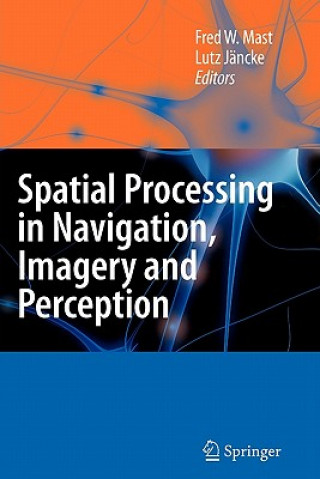
Kézbesítés
Vásárlási tanácsadó





Nem vált be? Semmi gond! Nálunk 30 napon belül visszaküldheti
 Ajándékutalvány
bármilyen értékben
Ajándékutalvány
bármilyen értékben
Ajándékutalvánnyal nem nyúlhat mellé. A megajándékozott az ajándékutalványért bármit választhat kínálatunkból.
Spatial Processing in Navigation, Imagery and Perception
 Angol
Angol
 467 b
467 b
30 nap a termék visszaküldésére
Ezt is ajánljuk


The processing of spatial information is an increasingly important topic with new findings emerging from several disciplines especially within the last few years. These disciplines are cognitive neuroscience, cognitive psychology, sensorimotor integration, neuropsychology and neuroanatomy. The aim of this book is to bring together a group of internationally highly renowned researchers from these disciplines. The book serves as a state-of-the-art platform, on which the very latest developments in spatial processing are presented. It will be useful for clinicians, experimental scientists, and graduate students. With respect to the teaching aspect, the editor s judgment is based on long-term experience in teaching cognitive neuroscience, cognitive psychology, and neurophysiology.§The mechanisms that underlie the processing of spatial information are explored in human and animal research without much crosstalk across disciplines. The reader of the book will learn to see several connections across disciplines. For example, a contribution on mental imagery by Stephen Kosslyn, which is highly related to studies with neglect patients (Pizzamiglio) who are unable to appropriately imagine their environment. Several contributions will then tie in knowledge from basic neuroscience such as Berhoz contribution focusing on the hippocampus and its role in navigation. All contributions are strongly related to at least three other contributions.The processing of spatial information is an increasingly important topic, especially in recent few years, with new findings emerging from such diverse disciplines as cognitive neuroscience; cognitive psychology; sensorimotor integration; neuropsychology and neuroanatomy. Bringing together contributions from a group of internationally highly renowned researchers from across these disciplines, this book offers a state-of-the-art platform on which the latest developments in spatial processing are presented.Spatial Processing in Navigation, Imagery and Perception serves as a state-of-the-art platform, on which the very latest developments in spatial processing are presented. Spatial processing is centrally involved in almost any cognitive function and the neural underpinnings of spatial functions are much more complex than they have been conceived before. Studying spatial processing helps to explore how basic cognitive functions operate such as language, attention, perception, movement control and mental imagery. The processing of spatial information is distributed in complex cortical and sub-cortical structures and we are now in a position to better understand the underlying neuroanatomy and neurophysiology. This is made possible by the advent of novel techniques such as structural and functional in vivo anatomy, modeling, and sophisticated behavioral research tools. Modern neuroscientific techniques have been in many ways the catalyst of this research but there is also a revival of behavioral methods used in studies on spatial processing. It is in fact the fruitful combination of both the neuroscientific and behavioral approaches why this exciting field has progressed so far and is still progressing for many years to come.§Research on spatial processing is not only restricted to basic science but rather has important applied implications. It is tremendously important to know how the human brain is accomplishing spatial tasks in real life scenarios such as driving a car, orienting oneself in large scale cities, postural control or playing various sports like baseball, soccer or tennis. Moreover, knowing more about plasticity and training related influences on spatial functions will have a huge impact on how to efficiently insert new technologies in everyday life.§The findings presented in Spatial Processing in Navigation, Imagery and Perception emerge from different disciplines such as cognitive neuroscience, cognitive psychology, neuropsychology, neuroanatomy, computer science and robotics. The reader will learn to see several connections across these disciplines. Chapter authors are the most respected and internationally renowned researchers in the field. This book will be useful for experimental scientists, clinicians and graduate students.
Információ a könyvről
 Angol
Angol
Kategória




 Hogyan vásároljunk
Hogyan vásároljunk


























